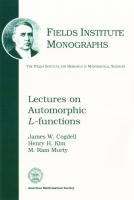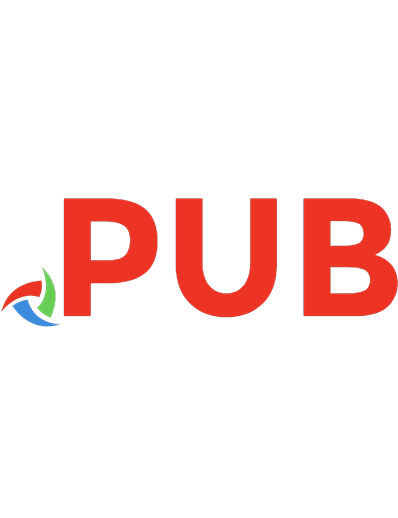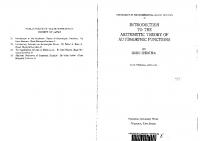Lectures on the Theory of Automorphic Functions, Vol.1 9787040478402, 7040478404
430 15 7MB
English Pages 561 Year 2017

- Author / Uploaded
- Robert Fricke
- Felix Klein; (trans.) Arthur M. DuPre
- (proofread) Patrick Boland
- Commentary
- Bookmarks added
Table of contents :
Why should one open and read Klein-Fricke and Fricke-Klein? -- John Coates
Reference
Preface
Contents
First Volume: The discontinuous groups of linear substitutions of one variable
0. Introduction. Developments concerning projective determinations of measure
0.1 The projective determinations of measure in the plane and their division into kinds
0.2 The motions belonging to a determination of measure and symmetric transformations of the plane into itself. The variable ζ in the parabolic case
0.3 Setting up all collineations of the conic section z_1 z_3 - z_2^2 = 0 into itself. Behavior of the associated ζ
0.4 The group of the "motion and symmetric transformations" for the hyperbolic and elliptic planes
0.5 General definition of the ζ-values for the points of the projective plane
0.6 The ζ-values in the hyperbolic plane. The ζ-halfplane and the ζ-halfplane
0.7 The hyperbolic determination of measure in the ζ-halfplane and on the ζ-halfsphere
0.8 Remarks on surfaces of constant negative curvature
0.9 Illustrations of the motions of the projective plane into itself by figures
0.10 The elliptic plane and the ζ-plane resp. ζ-sphere
0.11 Transferring the elliptic determination onto the ζ-plane and ζ-sphere
0.12 The hyperbolic determination of measure in space and the associated "motions"
0.13 Connection of the circle-relations with hyperbolic geometry. The rotation subgroups in hyperbolic space
0.14 Mapping of the hyperbolic space onto the ζ-halfplane
0.15 Concluding remarks to the introduction
Part I. Foundations for the theory of the discontinuous groups of linear substitutions of one variable
1. The discontinuity of groups with illustrations by simple examples
1.1 Distinction between continuous and discontinuous substitution groups
1.2 Distinction of properly and improperly discontinuous substitution groups
1.3 Recapitulation and completion regarding the discontinuity domains of cyclic groups
1.4 The groups of the regular solids and the regular divisions of the elliptic plane
1.5 The division of the ζ-halfplane and the hyperbolic plane belonging to the modular group
1.6 Introduction and extension of the Picard group with complex substitution coefficients
1.7 The tetrahedral division of the ζ-halfsphere belonging to the Picard group
1.8 The discontinuity domain and the generation of the Picard group
1.9 Remarks on subgroups of the Picard group. Historical material
2. The groups without infinitesimal substitutions and their normal discontinuity domains
2.1 The concept of infinitesimal substitutions
2.2 The proper discontinuity of the groups without infinitesimal substitutions
2.3 Introduction of the concept of the polygon-and the polyhedron-groups
2.4 Introduction of the normal discontinuity domains of the projective plane for rotation groups
2.5 The vertices and edges of the normal polygons for principal circle groups. First part: the corners in the interior of the ellipse
2.6 The vertices and edges of the normal polygons for principal circle groups. Second part: the vertices on and outside the ellipse
2.7 The normal polyhedra in the hyperbolic space and their formation in the interior of the sphere
2.8 The normal polyhedra on and outside the sphere
2.9 The behavior of the polygon groups on the surface of the sphere. First part: General
2.10 Continuation: Special consideration of the groups with boundary curves
2.11 The normal discontinuity domains for the groups consisting of substitutions of the first and second kinds
2.12 Carrying over the normal discontinuity domains onto the ζ-plane and into the ζ-space. Historical material
3. Further approaches to the geometrical theory of the properly discontinuous groups
3.1 The allowed alteration of the discontinuity domains, in particular for principal circle groups
3.2 Continuation: Allowed alteration of the discontinuity domains for polyhedral groups as well as non-principal circle polygon groups
3.3 Definition of all groups without infinitesimal substitutions by suitable discontinuity domains. Effectuation in the principal circle case
3.4 Continuation: Definition of the polyhedral groups by discontinuity domains
3.5 Continuation: General definition of the polygon groups by suitable discontinuity domains
3.6 Classification of all groups without infinitesimal substitutions according to the form of the discontinuity domain and the regular divisions arising from these
3.7 The generation of the groups and the relations subsisting between the generating substitutions
3.8 Continuation: The generators and their relations for polyhedron groups as well as for arbitrary polygon groups
3.9 Introduction of the closed resp. partially closed surfaces for polygon groups of the first and second kinds
3.10 The canonical discontinuity domains of the polygon groups
3.11 The composition of the polygon groups
3.12 Introduction of the homogeneous substitutions and groups
3.13 The isomorphic splittability of polygon groups without secondary relations
3.14 The homogeneous form of the primary relation between the V_i, V_{a_k}, V_{b_k}
Part II. The geometrical theory of the polygon groups of ζ-substitutions
1. Treatment of the rotation groups on the foundation of the normal discontinuity domains
1.1 Disposal of the elliptic rotation groups
1.2 The normal hexagon of the parabolic rotation groups
1.3 Relation of the normal hexagon of the parabolic rotation groups to the reduction of binary quadratic forms
1.4 The parabolic rotation groups with elliptic substitutions
1.5 Extension of the parabolic rotation groups by substitutions of the second kind
1.6 Continuation: Parabolic rotation groups of the second kind with elliptic substitutions
1.7 The non-rotation groups with two boundary points
1.8 Extension of the groups with two boundary points by substitutions of the second kind
1.9 New explanations concerning the introduction of the normal polygons of the hyperbolic rotation groups
1.10 Investigation concerning the cycles of accidental vertices of the normal polygons P_0
1.11 Introduction of certain curves of the third order belonging to the substitution-triples V, V', V'' of the accidental vertices
1.12 Additional remarks concerning the curves of third order of the triple V, V', V''
1.13 The domains Q belonging to the fixed polygon vertices. The reciprocity theorem of the normal polygon
1.14 The species concept and the different types of normal polygons of the individual species
1.15 The occurrence of special types of the normal polygons of the species (p, n)
1.16 The alteration of the normal polygons for monodromy of the centers C_0
1.17 The "natural" discontinuity domains of the hyperbolic rotation groups of the first kind
2. The canonical polygons and the moduli of the hyperbolic rotation groups
2.1 Introductory remarks. The canonical polygons of the species (0,3)
2.2 The canonical polygons of the species (1,1) in their first form (as rectilinear quadrangles)
2.3 The general form of the canonical polygons for the species (1, 1)
2.4 The double-n-angle of the species (0, n) and its transformation
2.5 Production of the canonical polygons of the species (0, n) from the double-n-angles
2.6 The canonical polygons in the case of an arbitrary species (p, n)
2.7 Continuation: Elimination of the convex angles possibly arising for the rectilinear canonical polygons of the species (p, n)
2.8 Transformation theory of the canonical polygons of an arbitrary species (p, n)
2.9 Continuation: The elementary transformations of the third and fourth kinds. Final result
2.10 The invariants of substitution pairs V_1, V_2
2.11 Introduction of the moduli j_1, j_2, j_3 for the canonical polygons of the species (0, 3)
2.12 The system of the characteristic conditions for the moduli of the species (0, 3). The manifold of all groups (0, 3)
2.13 The moduli and their characteristic conditions for the canonical polygons of the species (1, 1). manifold of the groups (1, 1)
2.14 Introduction of the moduli of the species (0, n). Composition considerations and determinations of sign
2.15 Adjunction of the invariants j_{123}, j_{234}, .... Relations for the moduli of the species (0, n)
2.16 The setting up of further conditions valid for the moduli of the species (0, n)
2.17 Systematic collection and completeness proof of the characteristic conditions for the moduli of the species (0, n)
2.18 The families of group classes contained in the species (0, n): continuity consideration and existence proof
2.19 The characteristic conditions for the moduli and the manifold of all groups of the species (p, n)
2.20 The transformation of the systems of moduli and the modular groups of the individual species (p, n)
2.21 Special study of the modular transformations for the two species (0, 4) and (1, 1)
3. Study of the circular-arc quadrangles without principal circle and remarks on other non-rotation groups
2.1 Geometrical derivation of the seven types of circular-arc quadrangles
2.2 Determination of the seven types of circular-arc quadrangles by their invariants
2.3 Preparations for the investigation of the boundary curve for the quadrangle of the first type with four angles zero
2.4 Various approximative constructions of the boundary curve for the quadrangle of zero angles
2.5 The four kinds of points on the boundary curve G. Course of the boundary curve with respect to parabolic points
2.6 Continuation: Course of the boundary curve at hyperbolic and loxodromic places
2.7 Description of the quadrangle nets of the second through sixth types
2.8 Further examples of non-rotation groups of the first and second kinds
Part III. Arithmetic methods of definition of properly discontinuous groups of ζ-substitutions
1. The rotation subgroups inside the Picard groups and the associated binary quadratic forms
1.1 The Gaussian forms and the modular group
1.2 Introduction of the Dirichlet and Hermitian quadratic forms
1.3 Geometrical interpretation of the Dirichlet and Hermitian forms
1.4 Treatment of the equivalence problem for the definite Hermitian forms
1.5 Reduction theory of the Dirichlet forms
1.6 The transformation of the Dirichlet forms into themselves
1.7 Reduction theory of the indefinite Hermitian forms
1.8 The reproducing groups of the indefinite Hermitian forms
1.9 The reproducing groups of the Hermitian forms belonging to the determinant D = 5
1.10 The reproduction group of the Hermitian forms belonging to the determinant D = 7
1.11 Theory of the Gaussian forms in projective-geometrical form
1.12 The projective form of the Picard group
1.13 Theory of the Hermitian and Dirichlet forms in projective-geometric form
2. The reproducing groups of ternary and quaternary quadratic forms
2.1 Approach to the groups to be investigated and proper discontinuity of these
2.2 Equivalence and commensurability of the reproducing groups Γ_f and Γ_F
2.3 Existence proof of the reproducing groups of the ternary forms f(z_i) of both kinds
2.4 Existence proof of the reproducing groups of quaternary forms F(z_i)
2.5 The occurrence of elliptic and parabolic substitutions in the groups Γ_f and Γ_F
2.6 Historical remarks concerning ternary and quaternary forms
2.7 Report on Selling's treatment of the ternary quadratic forms
2.8 Arithmetic formation law of the ζ-groups Γ_f of the indefinite forms f(z_i)
2.9 New methods of construction of the discontinuity domain of the individual principal circle group Γ_f
2.10 Examples of reproducing groups of real forms f(z_i)
2.11 Continuation: Groups [p, q, r] incommensurable with the modular group
2.12 Arithmetic formation law of the ζ-groups Γ_f for complex ternary forms f(z_i)
2.13 Examples of reproducing polyhedron groups Γ_f
2.14 Arithmetic formation laws for the reproducing groups of quaternary forms F(z_i)
2.15 Example of a reproducing group Γ_F
3. A special kind of principal-circle and polyhedron groups with integral algebraic substitution coefficients
3.1 Definition of the groups [p, q, r] for arbitrary number fields Ω
3.2 Various extensions of the groups [p, q, r]
3.3 Lemmas from the theory of units
3.4 The discontinuity of the groups [p, q, r] with real substitution coefficients
3.5 The discontinuity of the groups [p, q, r] with complex substitution coefficients
3.6 Approach to the principal-circle groups of the character (0, 3) to be treated
3.7 Discussion of the three conditions for proper discontinuity
3.8 The groups [p, q , r] belonging to the signatures (0,3; 2, l_2, l_3) classified
3.9 Proof of the identity of the groups (0,3; 2, l_2, l_3) classified and the arithmetically defined group [p, q, r]
3.10 Approach to the principal-circle groups of the character (1, 1) to be treated
3.11 The groups (1, 1; l) with quadratic fields Ω for l = 4, 5, 6
3.12 The groups (1, 1;2) and (1, 1;3) with quadratic numbers fields Ω
Commentaries
1. Commentary by Richard Borcherds on Elliptic Modular Functions
2. Commentary by Jeremy Gray
3. Commentary by William Harvey on Automorphic Functions
4. Commentary by Barry Mazur
5. Commentary by Series-Mumford-Wright
6. Commentary by Domingo Toledo
7. Commentaries by Other Mathematicians
Index






![Lectures on the Theory of Functions of a Complex Variable, Vol. 1: Holomorphic Functions [1 ed.]](https://dokumen.pub/img/200x200/lectures-on-the-theory-of-functions-of-a-complex-variable-vol-1-holomorphic-functions-1nbsped.jpg)


